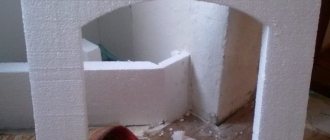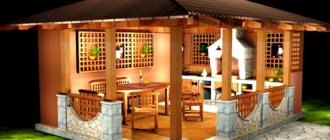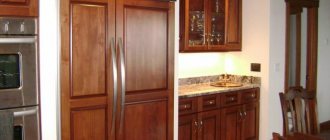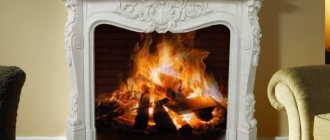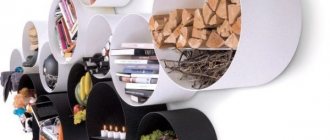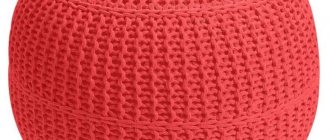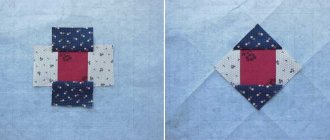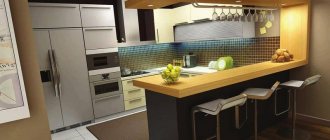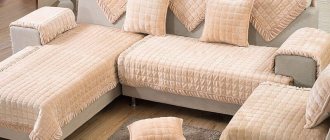Advantages
Modern technologies keep pace with people's needs. It is for this reason that the long-known brick stoves have been replaced by new fireplace stoves. This design is a monoblock with a pipe channel and is installed on a single base. Moreover, each element has its own special meaning.
Conventional stoves have no decorative value, but you can cook with them. Fireplaces can please the eye and heat the room. But the fireplace-stove combines the functionality of both devices with an interesting design. It's like a fireplace with a stove - very convenient and functional. The main advantages of a brick stove-fireplace:
- The structure can warm up the air in the room quite quickly.
- The stove and fireplace can be used separately from each other. You can only cook or only heat the room - as you wish.
- Efficiency is about 80%.
- Ash pans with holes under each firebox make the cleaning process very simple and quick.
- When manufactured with high quality, a brick fireplace stove will serve for decades.
The structure can be installed in such a way that the stove will be localized in the kitchen space, and the fireplace in the living room. If a real master gets down to business, the fireplace stove turns into a real work of art and will decorate your home for many years. A brick fireplace stove would be a good choice for a country house. This will save on heating and electrical costs in general. This design can also be used as needed.
Types of brick fireplaces
There are different types of fireplaces that can be installed in a country house or in a small country house. First of all, brick fireplaces are divided into wall-mounted and built-in.
Photo of a corner fireplace
Built-in
A special feature of this design is that the fireplace is installed inside a load-bearing wall. A chimney is pre-installed inside this wall. This option is quite complex, so it is rarely chosen for independent construction. In addition, the creation of such a fireplace is possible only at the stage of designing a house.
Wall mounted
The most successful option for self-production. It can be easily done both in a country house and in a small country house, without having experience in constructing such structures. You can create a wall-mounted fireplace both at the design stage and at any time after building the house. However, if you need to build a fireplace in an already finished house, you must first create a separate foundation.
Photo of a direct fireplace
Wall-mounted fireplaces can be either straight or corner. The last option is the most compact, so it is perfect for a small room. In addition, its construction is much simpler than direct construction, and significantly less material is required.
Options
There are quite a few variations of brick units. They differ in complexity and functionality. The most common types are: Swedish, Finnish, Russian and Dutch. There are also modified versions of stoves that are named after their creators.
There are ovens that do not have a hob at all. They represent a rudimentary wall structure with smoke exhaust channels, fireboxes, cleaning and blower chambers located between them. Such units are used for heating. Another option is a fireplace-stove with a heating and hob surface. Such stoves attract people with their versatility. They are more complex to design and install. Let's consider several interesting types of brick fireplaces and stoves:
With open firebox
Fireplaces with an open firebox allow you to warm up the air in the room in a fairly short time. If this design includes a hob, cooking is very easy. Owners of such fireplace-stoves can install barbecues right in the house and barbecue at any time of the year.
With air heating
Air-heated fireplaces are considered the best for heating a home. In such designs, a cast iron firebox is used. The duct system extends throughout the house and the casing in combination gives the desired result - complete heating. The system works in such a way that cold air is directed directly into the firebox, heats up and rises up through the pipes.
With water heating
Fireplaces with water circuits are gaining popularity. This design may include a heating and hob panel. A stove connected to heating has a great advantage over its counterparts - it pleases the eye, warms the whole house, and makes it possible to cook. Such designs are often used for baths.
As already mentioned, there are modification options. But knowing the basic models, you can easily choose the format that is convenient for you.
Corner fireplace and its advantages
Thanks to the small volume of the fireplace, it significantly saves the usable area of the room. It can be installed not only in large rooms, such as a living room, but also in a bedroom.
It should be remembered that a wood-burning fireplace requires a constant supply of oxygen.
The corner fireplace has two adjoining walls, this is advantageous in that it can heat 3 rooms at the same time.
The corner fireplace stove evokes interest with its graceful shapes and perfectly complements your favorite interior with its splendor.
Stylistics
A well-chosen fireplace should be combined with the overall style of your interior. Only then will such an addition look beautiful. Fireplace stoves are often made independently or to order. The Finnish model is quite popular. Let's look at the most popular styles in which this unit is made:
Minimalism
Minimalism is characterized by strict forms and lines. In houses of this style, small fireplaces are installed, which serve a decorative and heating role. A laconic design with a minimum number of decorative parts is the perfect set. Any room in your home will become even more cozy when it has a mini fireplace.
A small fireplace stove will fit well into a minimalist interior and will delight you and your guests. In addition, this option is well suited for houses with a small area. Here you can also install a structure in which the stove will face the kitchen, and the fireplace itself will face the living room.
Classic
Fireplaces of this style were the first. They were installed by noble people as an interesting piece of furniture and a sign of their superiority. Such fireplace stoves always have the correct shape and only expensive finishing or carving.
Such units usually go flush with the wall. This arrangement determines the main decorative accent on the firebox itself. All designs of such furnaces include a U-shaped portal. But you can also choose a non-embedded option. In this case, the fireplace stove is located against the wall, and the chimney is covered with a stylized casing.
Modern
This type of fireplace stove is often chosen by young people. You can buy a lot of interesting options. Such units are often used as architectural details. These fireplaces are often installed so that they blend into the wall and resemble a window with a fire. An interesting option is when a double-sided fireplace stove is installed in the interior wall. With this arrangement, you can use the structure as a piece of furniture on one side, and on the other as a stove.
Rustic
These are country style fireplaces. This design will look good in a wooden house. Natural wood ceilings, harmoniously selected wall finishes and dark floors. Moreover, using wallpaper in this case is completely impractical. They will quickly become unusable due to the stove. A Russian stove works well. Carved decorative elements will add originality and exclusivity.
Venetian
Fireplace stoves of this style are quite massive and clearly stand out against the background of the wall. They are designed to show everyone around their power and sophistication in one person. In an interior of the appropriate style, such fireplaces look like a charming integral attribute.
Principle of operation
Any stove has three main components: firebox, pipe, chimney. The main part is the firebox. This is where the wood burns. There is a hole at the bottom. Through it, air enters the firebox, which is necessary for combustion. This hole is covered with a special grill, so the firewood does not fall out. Air gets inside the firebox, and ash and other combustion products fall from the firebox into the hole.
There is a special door that allows you to put firewood into the firebox. And the firebox itself is closed on all sides. Just above the firebox is the hob. It is heated by fire and allows you to cook food. Oven ovens work the same way.
The ash pan chamber is located under the firebox. It also has a door to allow the chamber to be cleaned. The door is also able to regulate the amount of air that enters the firebox. In the arch of the firebox there is another hole - hailo. It is through it that hot air comes out, which heats the oven.
The pipes are designed to remove combustion products from the furnace. There are two types:
- Mounted. Installed on the stove.
- Indigenous. They may have their own foundation or be located inside a wall.
The most important feature that distinguishes a stove from a fireplace is that in the second option you can freely observe the fire. To prevent heat from escaping into the pipe, a heat shield is installed. In the combined version, the stove-fireplace has all the advantages of a stove and allows you to observe the flame.
How to choose a site for construction
It is customary to attach such a fireplace to a load-bearing wall opposite the outer door and away from the windows. This arrangement is considered optimal for efficient heating of the room. At the same time, there are many options for installing a fireplace: build it into the wall, place it in a blind corner, or install the device separately. The choice of location depends on the interior of the room and the availability of free space.
A properly built fireplace will not smoke or throw sparks, but it should still not be placed near flammable interior items. It is advisable to choose a place in such a way that there are no windows in the immediate vicinity of the fireplace, or opposite it: this way, maximum heat will be retained in the room.
Materials
The variety of available materials for making brick fireplaces and stoves is quite limited, but it allows you to create unique products. The units can be constructed from both ordinary bricks and figured bricks. When choosing a brick, its strength grade plays a big role.
Fireclay bricks (less commonly, quartz bricks) are used quite often because they are not sensitive to high temperatures. They lay out the area near the firebox. Heat resistant material is a must. Figured brick is relevant if you do not plan to decorate the fireplace stove. If any decorative work is planned, the external data of the masonry itself does not matter.
Clinker brick is one of the varieties of quartz. But in its production, slightly modified technologies are used. It is not used so often for two reasons: the material is quite expensive and heavy. But if your stove is large, then such a brick is perfect for building a foundation.
In order for the appearance of the structure to please the eye, you need to be guided by certain requirements when laying out the facing layer. The brick should be fairly solid and have good heat transfer. Paint will help create a unique look for your fireplace stove.
Methods for finishing fireplaces
If high-quality facing bricks were used when laying the external walls, then all that is required to improve the aesthetics of the structure is to fill the joints. To do this, they are rubbed down, and the outer surface is refined using a special tool - jointing. It is also necessary to sand the uneven bricks and coat the walls with a special compound. The simplicity of this method has a big disadvantage - over time, the surface of the fireplace darkens and loses its attractiveness.
A very simple way to improve the appearance of your fireplace is by plastering. Ready-made decorative compositions, which are presented in a wide range on the shelves of retail chains, are best suited for this. You can begin plastering work only after the walls of the fireplace have dried and shrink. If necessary, the portal can be painted with water-based paint, but this can only be done after the finishing layer has completely dried.
A fireplace trimmed with natural stone, as if taken from the era of knights and fair ladies
Currently, there are many options for covering a fireplace with materials of natural or artificial origin. Tiles will help make the stove bright and irresistible. They will completely transform the portal of the heating device, making it especially warm and homey. Finishing with marble slabs or stone, on the contrary, will create the effect of an expensive and presentable structure. As for facing the fireplace with ceramic tiles, you should choose only heat-resistant varieties - majolica, clinker, porcelain stoneware or terracotta. Of course, when laying facing materials, you should use only special, heat-resistant adhesives.
Tools and accessories
Making a fireplace stove requires certain accessories. The most necessary:
- Kiln brick.
- Heat-resistant clay mixture.
- Door with heat-resistant glass.
- Cast iron firebox door.
- Iron door for chimney and ash pan.
- Furnace grates.
- Surface for cooking. A cast iron stove should have the number of burners you need.
- Corners and corner shelf. As a rule, they are made of steel.
- Steel sheet up to 3 mm. Asbestos or basalt sheets for thermal insulation.
- Pipe and parts for connecting the chimney opening.
- Rolls and boards of waterproofing.
- Mixtures of concrete and soil.
- Bags of crushed stone and sand.
- Ceramic granite or tiles.
You need to choose materials very carefully. The strength and durability of the fireplace stove depends on their quality.
Dimensions, diagrams and location of the hearth in the room
A brick fireplace will have dimensions that depend on the area of the room. The parameters of each node must be selected separately. For example, with a minimum area of 12 m², the width of the portal will be 50 cm and its height will be 42 cm. The firebox should be deepened by 30 cm, and the rear wall of the firebox should have a height of 36 cm. The width of the last part will be 30 cm, and the height of the smoke collector – 57 cm.
When choosing a brick fireplace design, you must also determine the cross-section of the chimney. If the walls are rough, then this parameter will be 14 x 27 cm. With smooth walls, the cross-section of the chimney will be 14 x 24 cm. The fireplace layout will be slightly different if the area of the room increases to 40 m². The width of the portal and its height will be 100 and 77 cm, respectively.
The depth of the firebox is 42 cm, and the height and width of the rear wall of the firebox will be 36 and 70 cm, respectively. The smoke collector will have a height of 80 cm. The cross-section of the chimney with rough and smooth walls will be 27 x 40 and 27 x 27 cm, respectively.
Dimensions and layout can be selected individually. The last point was discussed in more detail in the section types of heating devices. The main thing when choosing a location is to comply with all fire safety rules. For example, a smoke chamber must be built from refractory bricks, which are laid on the same mortar. You can use special blocks, laying a refractory lining on them. The walls of smoke chambers and fireboxes should be made smooth. Soot accumulates to a lesser extent on such surfaces.
The brick fireplace has a chimney, which is located in the outer wall made of fire-resistant materials. They are reinforced on the outside to prevent condensation of moisture from the smoke. If there are no suitable walls in the house, mounted or attached chimneys should be used. Main chimneys are also suitable.
Corner fireplace and its uniqueness
Corner heat sources in the house differ in their own way. For example, they are small in size, but distribute energy as evenly as possible throughout the room. If the masonry is done carefully and the deviation is minimal, a corner brick fireplace will be a piece of equipment that brings decorative beauty. This will certainly emphasize the status of the owner.
In order to get a beautiful fireplace, you must be patient; the clay solution has the property of floating. It is important to maintain a vertical surface and horizon level, as well as equal diagonal points. The quality of combustion products removal depends on this. Heat-insulating material should be laid between the fireplace and the wall. Sometimes quarter brick masonry is used for this purpose. It fits on the edge. Wire should be laid through 2 rows to strengthen the structure.
Rectangular fireplace diagram and drawing
By looking at the drawings of brick fireplaces, you can understand what dimensions they have. For example, a rectangular fireplace can have the following dimensions: 5 x 2.5. It provides for laying 33 rows. There is no door on the firebox. Good draft can be ensured by a smoke exhaust through channel. The heat capacity will decrease to increase efficiency. Empty channels should be laid along the chimney and firebox.
When you have chosen the dimensions of the fireplace, and if they correspond to the area of the room, you can calculate the amount of material. So, the inside of the firebox should be constructed of refractory bricks. It is capable of withstanding 1,100 ˚C. The massive part is laid from solid ceramic bricks. It must be grade 125 or higher. Then the material will withstand 750˚C.
It is prohibited to tie ceramic and refractory bricks, but the bond can be made with 3 mm wire, which is placed in the seams. It is important to maintain a joint thickness of 5 mm between bricks. If the material has flaws, for example, oblique corners, they must be trimmed to achieve the desired thickness of the seam. When laying out a wood-burning fireplace for your home, you should check the evenness of the rows with a plumb line or level, this will allow you to maintain the correct geometric shape of the structure.
Mini fireplace drawing
This design will fit perfectly into a room with an area of 16 m² or more. It can be built into a partition, then two rooms can be heated with one heating device at once. To increase heat transfer, the firebox should be folded without refractory bricks. Ceramics heats up faster because it retains less heat capacity.
To protect the firebox from temperatures, it is better to use a 3 mm metal sheet instead of a fireplace tooth. The order of such a design may include replacing the arch with a horizontal ceiling. To do this, use metal corners of the required length.
For construction, you need to purchase 235 ceramic bricks, 0.3 m³ of sand, a valve, a cleaning door, 2 air vents and a grate. Making a fireplace involves using roofing felt and cement, the latter must be purchased in a volume of 15 kg.
Elements and diagram of an English-type fireplace
This type of fireplace is also called classic and is one of the most ancient. Among the main distinctive features are:
- sloping back wall;
- open firebox;
- protruding tooth
Using refractory bricks and a mortar of clay and fireclay powder, it is necessary to fold the inner recess of the firebox. A little cement should be added to the solution. The outer contour is formed from solid ceramic material. The design of such a fireplace, although quite complex, has advantages in the form of high efficiency and stable draft.
For construction, you should prepare 350 ceramic bricks, 215 kg of mortar and 125 pieces of fireclay products. The first four rows must be made of ceramic bricks, now comes the turn of higher quality material grade 150. Such a fireplace can be installed in a room with a volume of 80 m³ or more. The design does not provide for a grate or a blower. If the room has a smaller volume, an oxygen supply should be installed for better combustion.
Three-level fireplace with grate
This structure is characterized by good draft in the chimney even with a height of 3 m and a large cross-section of the internal part of the chimney. The structure can be installed in a room with high humidity. To carry out the work you will need:
- ceramic brick;
- grate;
- steel corner;
- clay mortar;
- fireclay brick;
- smoke valve.
Ceramic material will be used in the amount of 620 pieces, refractory bricks should be purchased in the amount of 220 pieces. There should be 2 grates, as well as steel corners.
Masonry technology
Before you line the fireplace-stove with bricks, you need to draw up a diagram. It reflects all the necessary elements in the right places. Construction takes place in several stages:
- Base. We dig a pit and fill the bottom with crushed stone. The formwork is constructed using planed boards, and the pit itself is filled with cement.
- After 3-5 days the work continues. The brickwork is covered with roofing felt. Now the bottom row of bricks is laid out.
- Next, drawings play a big role. In agreement with them, the remaining bricks are laid out and the casting is installed. In order for the brick to have better contact with the mixture, it is soaked in water. The order is of great importance. Stick to it and you won’t have to redo the work. The inner sides of the furnace are smoothed during the process so that combustion products do not subsequently settle there.
- Now the chimney. It is important to remember fire safety measures here.
- The fireplace stove should dry naturally. This takes literally a few weeks.
- During the period of active drying, the oven is heated. Do this until all seams are the same color.
Basic principles of fireplace construction
For fireplace masonry, you can use different orders, but any option has general principles:
Corner fireplace
- the first row of bricks should be installed on edge, and the next rows should be installed flat;
- the first two rows are the base;
- bricks should be used without breaks, cracks, chips or other damage;
- if red brick is used for construction, it must first be soaked in water so that it does not absorb moisture from the solution;
- There is no need to soak refractory bricks before construction, just clean them from dirt and wipe them with a damp cloth;
- the thickness of the seam during construction should not be higher than 5 mm;
- if excess mixture appears between the seams, it must be removed before it hardens;
- it is necessary to apply a moderate amount of the mixture so that it guarantees reliable adhesion and does not go beyond the boundaries of the brick;
- during construction, a homogeneous solution without lumps should be used;
- the solution cannot be used to coat the inside of the fireplace;
- the optimal time for construction is summer or another warm period;
- The laying should begin from the corners so that it turns out smooth and neat;
- the bottom of the firebox should be at least three bricks from the floor.
For construction, it is necessary to choose the optimal scheme, purchase high-quality materials and prepare a fire-resistant mortar. It is worth paying attention to the external finishing of the product. After all, the fireplace will become a place around which all family members will gather.
Types of chimneys
The chimney acts as a channel system and is located inside the brickwork. The dimensions of the chimney directly depend on the dimensions of the fireplace stove. There are several types of chimneys:
- The simplest chimneys consist of certain sections that combine direct and return air flow. This design ends with a pipe. Return current areas are constructed from parallel channels. This is done in order to increase efficiency and improve air heating.
- Multi-turn chimneys. They differ from the previous ones only in the number of alternations of sections. The walls are heated more evenly because of this.
- Chimney without ducts. In such designs, everything is focused on the camera. Gases from the heil tend to the roof of the chamber, where they cool and descend back. The vapors give off their heat to the walls of the hood chamber. Exhaust gases exit into the pipe through openings at the bottom and side.
Any type can be used. It all depends on your needs.
Structural components of furnaces
Any brick oven consists of the main elements:
- foundation - the base on which a brick unit rests, weighing several tons;
- array - part of the stove, including cooking and combustion chambers, a system of smoke channels - smoke circuits, a ash pan with a grate;
- chimney - a chimney pipe rising above the stove mass.
The foundation for such a bulky and heavy structure is arranged separately from the main foundation of the house.
If there is a strip or column base under the building, you need to make sure that it does not come into contact with the foundation of the stove. This will avoid the occurrence of deformations from an unevenly distributed load, because under a brick unit it will be much higher.
The design of any heating and cooking stove consists of the main elements that provide sufficient draft: a blower, a grate, a firebox and smoke circulation channels
Monolithic foundations in private houses, especially small ones, are rare. If there is one, the stove can be installed directly on it. It is best to include the construction of such an object in the overall project in advance. When the house is already ready, the appearance of such additional load should be agreed upon with an experienced engineer.
The base of the furnace separates the combustion or gas chamber from the foundation. These are several rows of solid brickwork, which heat up and release some of the heat to the room, and also protect the base from overheating.
Above the base they make what is called a firebox. Below, under the combustion chamber, a small cavity is arranged - an ash pan. Above it is the actual firebox, in which the fuel burns. The blower and firebox are separated by a grate made of durable cast iron.
The firewood is placed directly on this grate. Through the blower and grate, the air necessary for combustion enters the fuel. At the same time, the necessary draft is created to remove smoke gases through the chimney system. But its design depends on what type of brick oven was chosen for the house.
The device can also be supplemented with elements such as a hob and oven. There are options for stoves with drying chambers and even with warm beds. Understanding the principles of the structure and operation of such a structure will help you choose the right type of stove, as well as resolve issues related to its construction.
Tips for use
Experienced stove makers can give useful advice on both the construction process and the operation of the fireplace stove. Do not use coniferous firewood, otherwise the chimney will become dirty and stop functioning. Firewood should always be well dried, this is important for long burning. Under no circumstances burn household waste and various types of waste paper - toxins will be released into the air.
A sauna stove must meet many criteria. Reviews show that it is better to pay attention to Finnish manufacturers. Every part of their product comes with a warranty, making repairs easy. A fireplace screen should be quite reliable.
When constructing with your own hands, always use the diagrams. They will help you understand exactly how the components should be placed in each line. Be sure to use a building level during this process. Corner and front structures are the most popular. But this depends on the overall layout of the house.
Similar articles
- Stove and fireplace: types, design, how to fold it with your own hands and make a pipe Preface The modern design of a heating stove allows, with minimal energy costs, to ensure a stable supply of thermal energy to…
- Do-it-yourself sauna stove - how to make it
Before starting work on building a sauna stove, you should decide on the type that is best suited for your specific conditions... - Construction of a brick fence from stone, brick, polycarbonate, slate. Photo, price
A fence constructed from brick is rightfully considered elite. The design requires considerable investment. The complexity of the work is complemented by...
